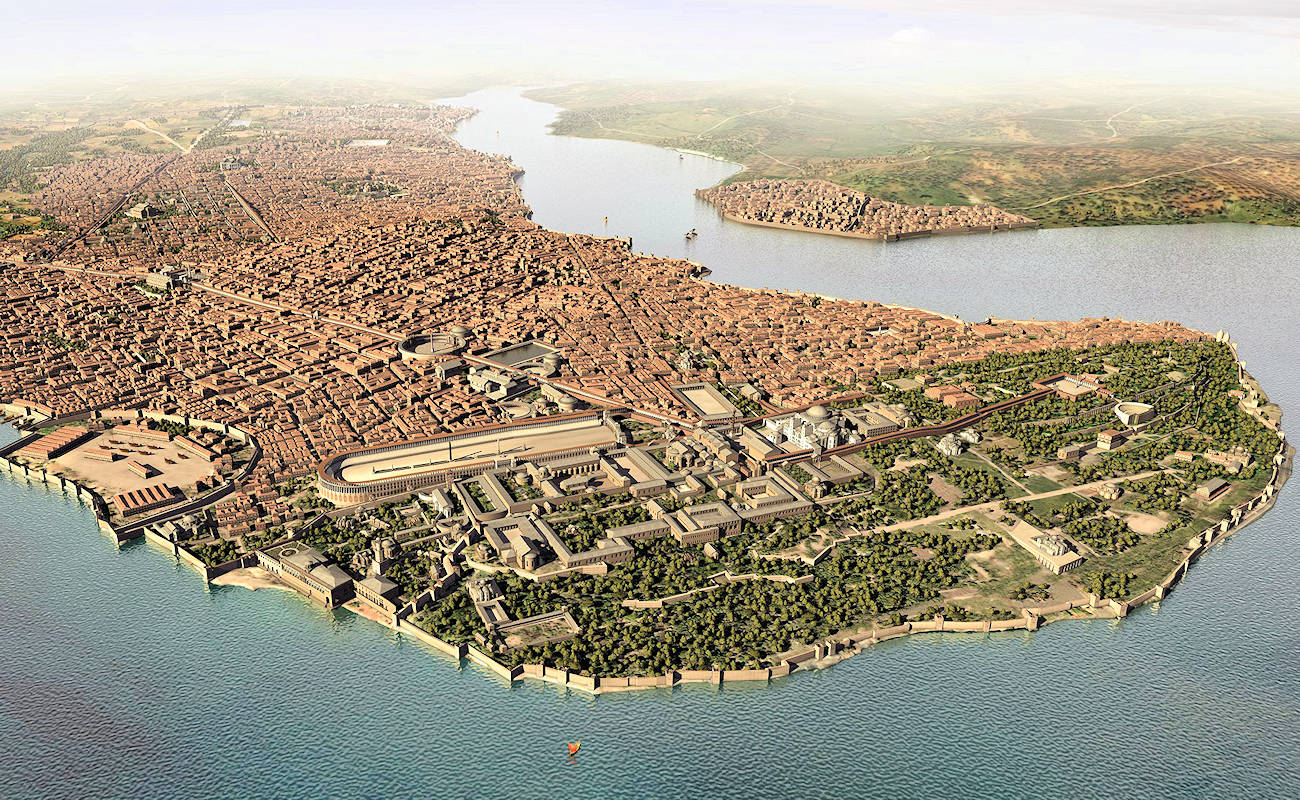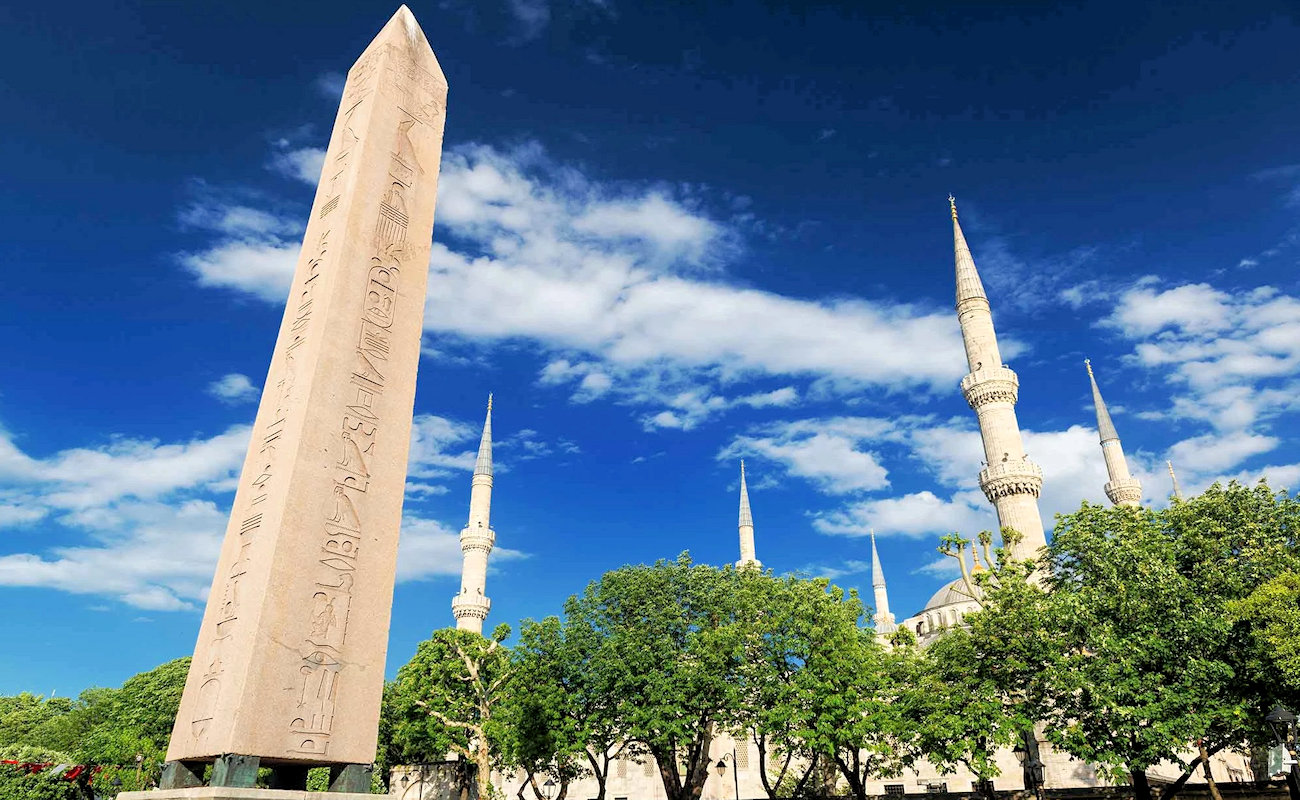
Constantinople
Constantinople is an ancient metropolis, which is now identified as Istanbul, located in modern-day Turkey. The city was initially occupied in the seventh century B.C. and blossomed as a prospering port, facilitated by its prime geographical position between Europe and Asia and its natural harbor. It transformed into the home of the Christian city of immense wealth and impressive architecture, “New Rome,” during A.D. 330 under Roman Emperor Constantine. For the next 1,100 years, Constantinople served as the capital of the Byzantine Empire, surviving both periods of prosperity and horrendous sieges, until it fell to Fatih Sultan Mehmed of the Ottoman Empire in 1453.
Bosporus
In 657 BCE, the ruler Byzas of the ancient Greek city of Megara founded a settlement on the west side of the Bosporus Strait, which linked the Mediterranean Sea and the Black Sea. The Golden Horn provided a natural and unspoilt harbor, and the settlement, known as Byzantium (or Byzantion), grew to become a prosperous port city.
Throughout the next few centuries, control of Byzantium alternated between the Persians, the Spartans, the Athenians and the Macedonians, as they competed for power in the region. The city was devastated by Roman Emperor Septimius Severus in circa A.D. 196; however, certain structures like the Baths of Zeuxippus, the Hippodrome and a fortification, managed to survive and were later rebuilt during the Byzantine Empire.
Following his victory against rival Licinius and gaining control over the Roman Empire in A.D. 324, Constantine I resolved to create a new capital at Byzantium named “Nova Roma”—New Rome.
Constantine I
Constantine expanded the territory of old Byzantium by dividing it into 14 sections and constructing a new outer wall. He attracted noblemen through gifts of land and transferred art and other ornaments from Rome for display in the new capital. The city’s wide avenues were lined with statues of great rulers such as Alexander the Great and Julius Caesar, as well as one of Constantine himself as Apollo.
The emperor also aimed to populate the city by offering residents complimentary food rations. With an existing network of aqueducts, he guaranteed water accessibility throughout the expanding city by building the Binbirdirek Cistern.
In AD 330, Constantine founded the city that would leave its mark on the ancient world as Constantinople, known as the Queen of Cities, Istinpolin, Stamboul and Istanbul. It would follow Roman law, practice Christianity, and select Greek as its main language. Despite this, it would also serve as a crossroads of various races and cultures due to its geographical position between Europe and Asia.
Justinian I
Justinian I, who held the throne from A.D. 527 to 565, persevered through the Nika Revolt in the early days of his reign and employed the opportunity to make major improvements to the city. He initiated prosperous military campaigns that allowed the Byzantines to regain territories surrendered with the fall of the Western Roman Empire in the fifth century, leading to an enlargement of its boundaries to encompass the Mediterranean Sea.
Justinian set up a standardized legal system with the Justinian Code that would serve as a model for future civilizations.
In addition, Leo III (reign: A.D. 717-741) fought back an Arab siege of the city, stabilized the throne, and promoted the spread of iconoclasm in the Empire. He was the initial emperor of the Isaurian dynasty.
Similarly, Basil I who reigned from AD 867 to 886, inaugurated the two-century-long Macedonian dynasty. Despite his inability to read and write, he emulated Justinian by carrying out renovations, attempting further codification of laws and successfully expanding the empire’s borders towards the south.
Constantinople Hippodrome
Constantinople withstood over a millennium as the Byzantine capital largely thanks to the defensive wall finalised under Theodosius II in the year 413. The new wall extended the city perimeter westwards from Constantine’s boundary by about a mile, covering a total of 3 and a half miles from the Sea of Marmara to the Golden Horn.
Following a series of earthquakes in the mid-5th century, an additional double wall was constructed, with the inner layer being approximately 40 feet tall and adorned with towers that reached another 20 feet.
The Hippodrome, constructed by Severus in the third century and extended by Constantine, functioned as a stadium for chariot races and other communal events, including parades and showcasing the incarcerated enemies of the emperor. With a length of over 400 feet, it is believed to have accommodated up to 100,000 spectators.

Christian and Muslim Rule
Although Constantine established New Rome while efforts were being made to establish Christianity as the state religion, this did not occur officially until Theodosius I took power in 379. He convened the First Council of Constantinople in 381, which backed the Council of Nicaea in 325, and declared the city’s patriarch as second only to Rome’s.
Following Leo III’s ban on the worship of religious icons in 730, Constantinople became a hub of the iconoclast controversy. Although the decision was reversed by the Seventh Ecumenical Council of 787, iconoclasm was reinstated as law less than 30 years later and persisted until 843.
As a consequence of the Great Schism of 1054, which caused Christianity to split into Roman and Eastern divisions, Constantinople became the Eastern Orthodox Church’s centre, which it remained even after the Muslim Ottoman Empire gained power over the city in the fifteenth century.
Fall of Constantinople
Constantinople, the Byzantine capital, was famous for its riches and withstood no fewer than twelve sieges during its over 1,000-year history. These sieges included assaults by Arab forces in the 7th and 8th centuries, in addition to Bulgarian and Rus campaigns in the 9th and 10th centuries.
In the early 13th century, the Crusades’ troops were redirected to Constantinople due to a power struggle, before continuing to Jerusalem. When their promised payments did not materialise, they conquered the city in 1204 and founded a Latin state.
Although the Byzantines regained control of Constantinople in 1261, the city continued as the only significant population centre of a diminished empire.
Following his ascent to the Ottoman throne in 1451, Fatih Sultan Mehmed prepared to launch a significant attack on Constantinople. With his overpowering army, combined with the benefits acquired through the application of gunpowder, he achieved what his predecessors could not, and secured Constantinople for the Muslim regime on May 29, 1453.
